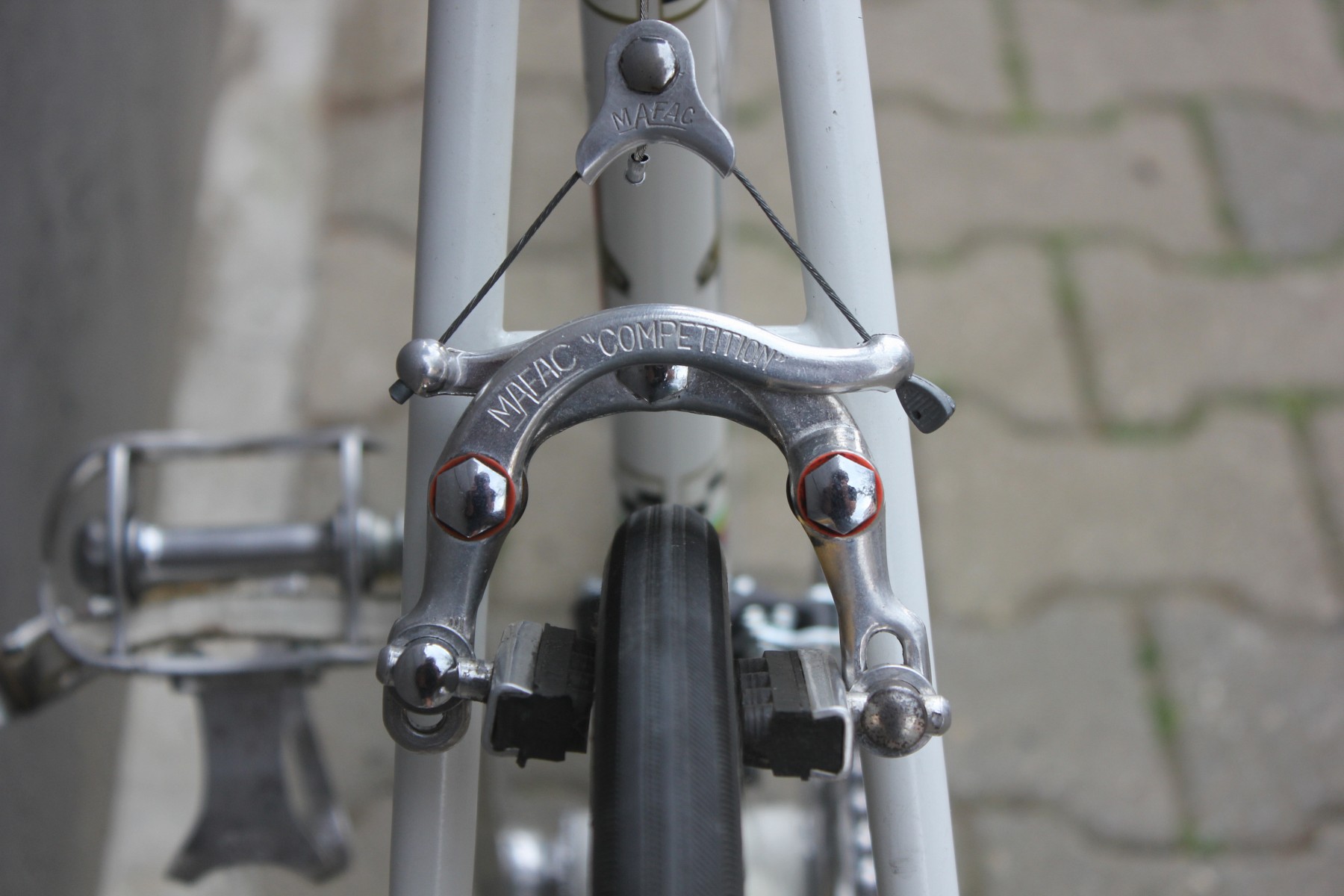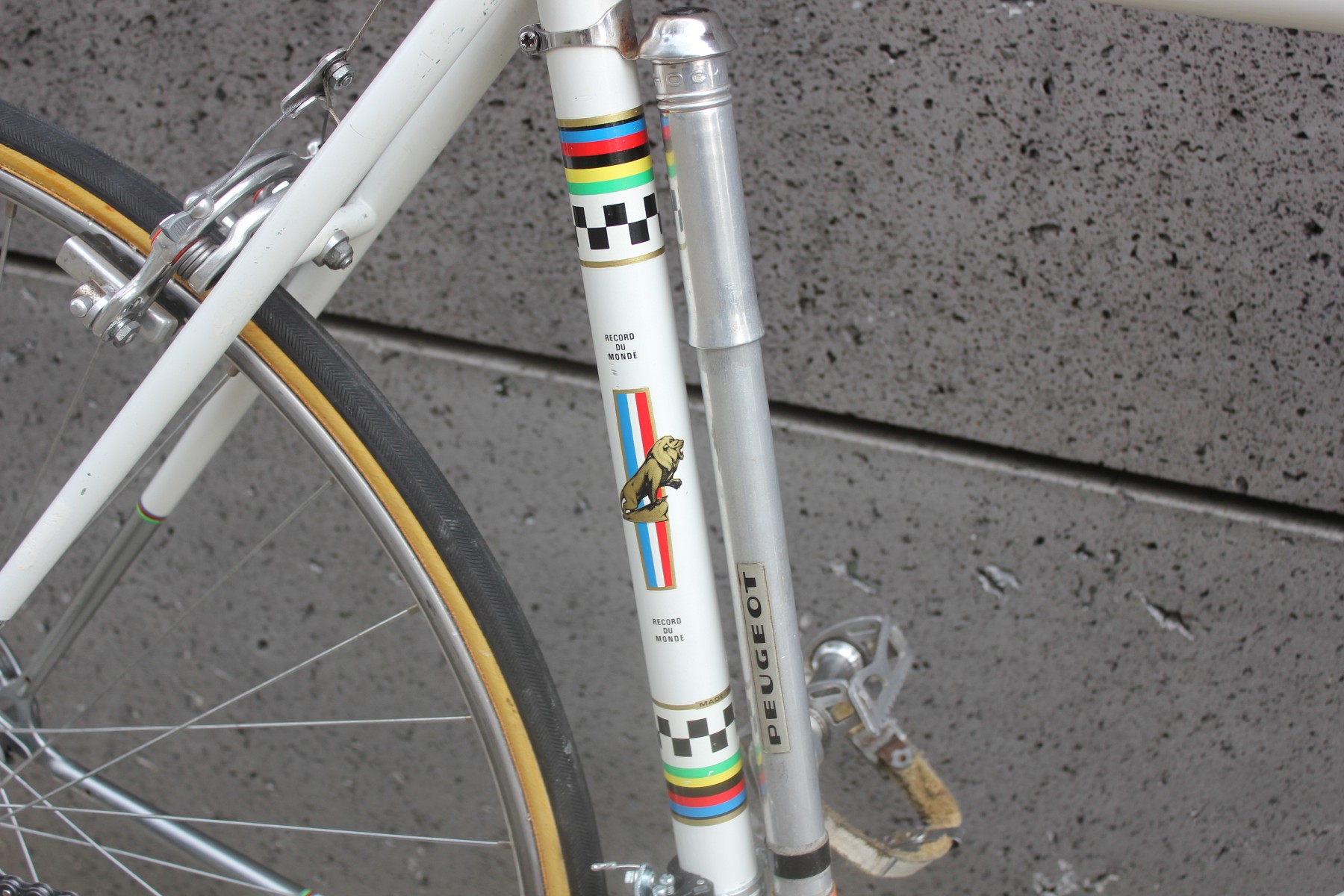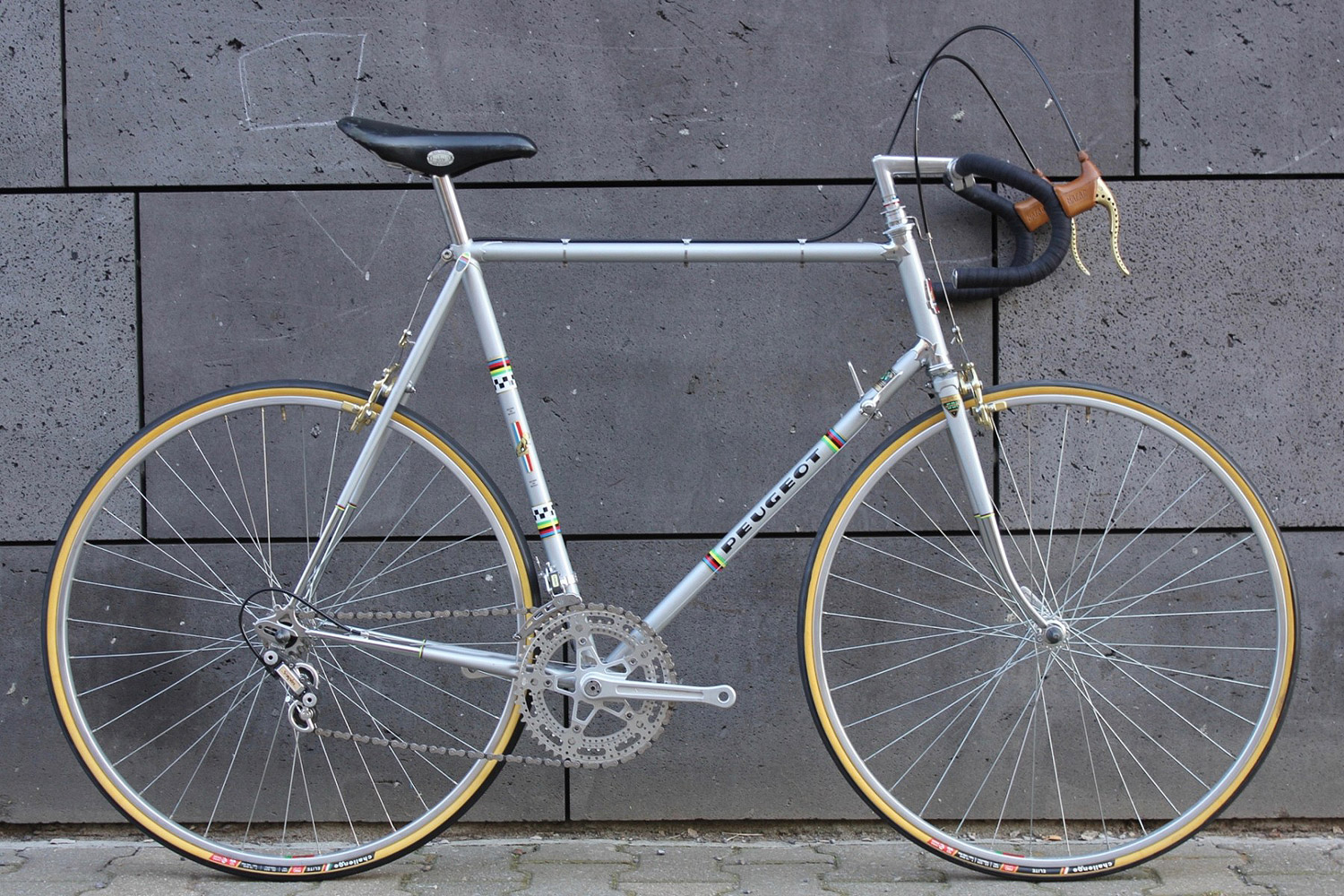PEUGEOT "PX10" 1975
50cm center/center – Simplex/Stronglight


Peugeot Legende PX10 aus 1975 im Originalzustand – kleiner 50cm Rahmen
Das Peugeot PX 10 war für viele Jahre das Topmodell im Peugeot Rennradprogramm und wohl eines der populärsten Rennräder seiner Zeit. Jeder von uns, der sich für klassische Rennräder interessiert, kennt diese charakteristischen Maschinen aus Frankreich.
1967 war ein sehr geschichtsträchtiges Jahr für den Radsport, aber auch für die Firma Peugeot, deren Radteam erstmals in den neuen Peugeot Farben weiß mit schwarz-weiß-kariertem Brustring im Peleton zu sehen war. Die Räder waren ebenfalls weiß und die berühmten Nervex Muffen am Steuerrohr schwarz lackiert. Ein Design, das stilbildend für eine ganze Epoche Peugeot Räder werden sollte. Die hochwertigen Rahmen sind ebenfalls gut an den verchromten Hinterbauten zu erkennen.
Kein geringerer als Eddy Merckx holte 1967 seinen ersten von drei Straßen-Weltmeistertiteln als Profi im Peugeot Trikot. Die Straßenmaschine, die der "Kanibale" benutzte war allerdings gar kein Peugeot Rad. Er benutzte bei seinem WM-Sieg eine Spezialanfertigung des italienischen Rahmenbauers MASI, der sich für die Beibehaltung der Optik extra die Nervex Muffen beschaffen mußte. Merckx hatte Masi schon früh in seiner Karriere kennengelernt und vertraute einfach auf dessen Künste im Rahmenbau. Nur wenige bemerkten den Schwindel. Für alle anderen war es ein Sieg eines Peugeot Rades. Für Peugeot war es natürlich ein guter Werbeeffekt. Merckx erzählt diese Andeuteten selber gerne. Jedoch betont er immer, dass die Peugeot keineswegs schlechter waren, bei ihm aber viel Aberglaube und Perfektion eine Rolle spielen, weshalb er einfache MASI vertraute.
Im selben Jahr wurde dann aber auch auf einem echten Peugeot Rad ein riesen Sieg eingefahren. Der Franzose Roger Pingeon gewann auf seinem PX10 die Tour de France.
Die Tour 1967 brachte Peugeot aber auch einen bis heute unvergessenen tragischen Tiefpunkt.
Beim Anstieg auf den legendären Mont Ventoux in der Provence passierte eine Tragödie. Der englische Weltmeister von 1965, Tom Simpson, ambitioniert um den Sieg kämpfend, brach geschwächt von Aufputschmitteln und Alkohol zusammen. Er verstarb kurz unterhalb des Gipfels. Heute steht an der Stelle ein Gedenkstein, an dem viele Radfahrer auf ihrem Weg zum Gipfel verweilen.
Das hier angebotene Rad stammt aus dem Jahre 1975 oder 1976. Gebaut natürlich aus besten Reynolds 531 Rohren mit Simplex Ausfallenden. Es ist bis auf den Laufradsatz komplett im Originalzustand.
Die Lackierung und der Chrom sind sensationell erhalten.
Alle Anbauteile funktionieren tadellos.
Wer ein kleines, geschichtsträchtiges Rad sucht, um beispielsweise eine Eroica zu bestreiten, der hat hier die Gelegenheit.
ENGLISH DESCRIPTION
The Peugeot PX 10 was for many years the top model in the Peugeot racing bike range and probably one of the most popular racing bikes of its time. All of us who are interested in classic racing bikes know these characteristic machines from France.
1967 was a very historic year for cycling, but also for the Peugeot company, whose cycling team could be seen for the first time in the new Peugeot colours white with black and white chequered brustring in the Peleton. The bikes were also white and the famous Nervex sleeves on the head tube were painted black. A design that would set the style for a whole era of Peugeot wheels. The high quality frames are also well recognizable by the chromed rear parts.
None other than Eddy Merckx won his first of three road world championship titles as a professional in the Peugeot jersey in 1967. The road machine used by the "Kanibale" was not a Peugeot wheel at all. He used a special production of the Italian frame builder MASI, who had to buy the Nervex sleeves to keep the optics. Merckx had met Masi early in his career and simply trusted in his frame building skills. Only a few noticed the swindle. For everyone else it was the victory of a Peugeot wheel. For Peugeot, of course, it was a good advertising effect. Merckx likes to tell these prey themselves. However, he always emphasizes that the Peugeot were by no means worse, but a lot of superstition and perfection play a role for him, which is why he trusted simple MASI.
In the same year, however, a huge victory was clinched on a real Peugeot bike. Frenchman Roger Pingeon won the Tour de France on his PX10.
But the 1967 Tour also brought Peugeot a tragic low point that is still unforgotten today.
The climb to the legendary Mont Ventoux in Provence was a tragedy. The English world champion of 1965, Tom Simpson, ambitiously fighting for victory, collapsed weakened by stimulants and alcohol. He died just below the summit. Today there is a memorial stone on the spot where many cyclists linger on their way to the summit.
The bike offered here was built in 1975 or 1976, of course from the best Reynolds 531 tubes with Simplex dropouts. It is completely in original condition except for the wheel set.
The paintwork and the chrome are sensationally preserved.
All attachments work perfectly.
If you are looking for a small, historic bike, for example to ride an Eroica, you have the opportunity here.
ABMESSUNGEN / DIMENSIONS
SATTELROHR / DOWN TUBE CENTER-CENTER
50.0 cm
OBERROHR / TOP TUBE CENTER-CENTER
53.0cm
Steuerrohr / Steerer TUBE
9.0 cm
STANDOVER
77.5 cm
Rohrsatz / Tubing
Reynolds 531
Ausfaller / Drop Outs
Simplex
AUSSTATTUNG / EQUIPMENT
STEUERSATZ / HEAD SET
Stronglight
INNENLAGER / BOTTOM BRACKET
Stronglight
KURBELSATZ / CRANKSET
Stronglight, 170mm
PEDALE / PEDALES
Lyotard
SCHALTHEBEL / SHIFTERS
Simplex , 2x6
SCHALTWERK / REAR DERAILLEUR
Simplex
UMWERFER / FRONT DERAILLEUR
Simplex
VORBAU / STEM
Atax 90mm
LENKER / BARS
Atax 390mm
LENKERBAND / BAR TAPE
NOS - New Old Stock
SATTELSTÜTZE / SEAT POST
Simplex
SATTEL / SADDLE
Arius
ZAHNKRANZ / SPROCKETS
Regina 14-23
KETTE / CHAIN
Sedis
NABEN / HUBS
Shimano
FELGEN / RIMS
Mavic
REIFEN / TYRES
Continental Giro
BREMSKÖRPER / BRAKE CALIPER
Mafac Racer
BREMSHEBEL / BRAKE LEVER
Mafac Racer
ZÜGE / CABELS
NOS - New Old Stock
BESONDERHEITEN / SPECIAL REMARKS
Originalzustand / Original state
l'Eroica tauglich / Eroica ready

PEUGEOT "PX10" 1975
50cm center/center – Simplex/Stronglight
VINTAGE VÉLO BERLIN
Petersburger Platz 2, 10249 Berlin
Tel. +49 01706347153
mail@vintageveloberlin.de

































